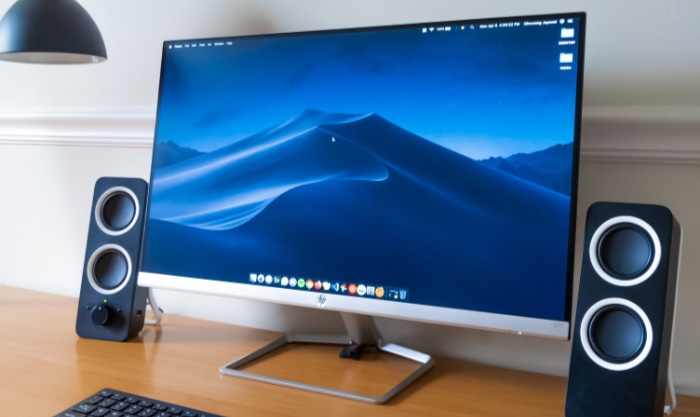Ultrawide vs. 4K: The Battle of the Monitors

Whether it's for professional tasks, content creation, gaming, or just leisurely streaming your favorite shows, the kind of monitor you choose significantly impacts your overall experience. Among the popular choices today, ultrawide and 4K monitors stand out as unique offerings, each with their distinct advantages and aspects to consider.
Ultrawide monitors, as the name suggests, offer an extended horizontal field of view, making them ideal for specific professional and gaming applications. On the other hand, 4K monitors, synonymous with superior picture quality, are known for their high resolution, providing exceptional detail and clarity.
But which is the best choice for you? Is it the immersive experience provided by the ultrawide monitors, or is the high-detail precision of 4K monitors more to your liking?
Understanding Ultrawide and 4K: Unpacking the Specs
Before we dive into the in-depth comparison between ultrawide and 4K monitors, it's crucial to understand their fundamental specifications and what they mean.
These specs play a vital role in determining the performance and functionality of the monitors, shaping your overall viewing or gaming experience. Let's unpack these technical aspects to give you a clearer picture.
What is an Ultrawide Monitor?
An ultrawide monitor refers to a class of screens that provide an aspect ratio typically greater than the conventional 16:9. The most common ultrawide monitors feature a 21:9 aspect ratio, translating to a screen that's significantly wider than standard widescreen monitors.
The ‘ultrawide' term is attributed to their broader horizontal field of view, which facilitates a more immersive viewing experience and a larger workspace.
Resolutions on ultrawide monitors can vary, with 2560×1080 and 3440×1440 being among the most common. These monitors are particularly popular among professionals who need expansive screen real estate and gamers who value immersive experiences.
Several brands have ventured into the ultrawide market, including LG, Dell, and Samsung, each offering an array of models with varying specifications.
Defining 4K: High Definition Taken Further
4K, also known as Ultra HD (UHD), stands for a horizontal display resolution of approximately 4,000 pixels. For television and consumer media, 3840×2160 is the dominant 4K standard, while the movie and production industry often utilizes 4096×2160.
Both resolutions quadruple the pixel count of Full HD (1920×1080), resulting in a significant leap in picture detail and clarity.
4K monitors excel when it comes to delivering high-resolution content, whether it's for professional tasks such as photo editing and 3D modeling or for viewing high-definition video content.
Brands like Asus, Acer, and BenQ are prominent in the 4K monitor market, providing a range of models with features tailored for various use cases.
In-depth Comparison: Ultrawide vs. 4K
Now that we've established a foundational understanding of both ultrawide and 4K monitors, let's explore a detailed comparison across several key factors.
Picture Quality: The Battle of Pixels
When discussing picture quality, the conversation inevitably leads to resolution – the total number of pixels that a screen can display. A 4K monitor, with its approximately 8.3 million pixels (3840 x 2160), surpasses even the highest resolution ultrawide monitors in terms of pixel count.
This advantage lends to incredibly sharp imagery and meticulous detail, particularly beneficial for activities requiring precision, such as photo editing and graphic design.
On the other hand, while ultrawide monitors may not match the sheer pixel count of 4K monitors, their expansive aspect ratio offers a unique advantage in terms of immersion and horizontal field of view. Also, the pixel density (pixels per inch) of an ultrawide can be similar to a 4K monitor, ensuring that the image quality remains crisp and clear.
Screen Real Estate: Spreading Out vs. Scaling Up
Screen real estate refers to the amount of space available for displaying information on the screen. Here, the choice between ultrawide and 4K depends largely on your specific needs.
Ultrawide monitors, with their extended width, provide more horizontal space. This attribute can be immensely beneficial for multitasking, as it allows users to comfortably open multiple windows side by side.
In contrast, 4K monitors, with their high resolution, can display a greater amount of content on the same-sized screen due to the increased pixel density.
However, this also means that interface elements and text can appear smaller, which might necessitate scaling adjustments in the operating system to maintain usability.
Immersion and Field of View: Embracing the Horizon
When it comes to immersion and field of view, ultrawide monitors generally have an edge. Their broader aspect ratio wraps around the user's field of vision, delivering a more immersive experience – a feature highly favored by gamers and movie enthusiasts.
While 4K monitors may not offer the same level of immersion in terms of width, they make up for it with unmatched clarity and detail, which is equally immersive in a different way.
The high resolution can make content more lifelike and engaging, particularly when viewing 4K movies or playing games that support 4K resolution.
Performance Requirements: The Hardware Question
Driving an ultrawide or a 4K monitor requires substantial graphical horsepower, especially for gaming or professional applications. In general, 4K monitors demand more powerful hardware due to the higher number of pixels that need to be rendered.
For ultrawide monitors, the hardware requirement is generally lower compared to 4K, but it's still greater than a standard 1080p monitor.
Therefore, when considering either type, it's crucial to ensure that your PC has the necessary graphical processing power to handle the increased load effectively.
Pros and Cons of Ultrawide Monitors

As with any technology product, ultrawide monitors have their unique advantages and limitations. Understanding these can help you make an informed decision based on your specific needs and preferences.
Advantages of Ultrawide Monitors
Enhanced Multitasking: The additional horizontal space offered by ultrawide monitors allows users to have multiple windows open simultaneously, facilitating efficient multitasking. For professionals who often work with multiple applications at once, this can be a significant productivity booster.
Immersive Gaming and Viewing Experience: With their extended field of view, ultrawide monitors provide an immersive experience that's hard to match with standard widescreen displays. This attribute is particularly beneficial for gaming and watching cinematic content.
Reduced Multi-Monitor Hassle: An ultrawide monitor can potentially replace a dual-monitor setup, eliminating the gap between screens and any alignment issues that might arise.
Disadvantages of Ultrawide Monitors
Limited Content Availability: Not all content is optimized for the 21:9 aspect ratio of ultrawide monitors. This means some games, movies, and software might not fully utilize the extended screen space or could display improperly.
Space Requirements: Ultrawide monitors require more desk space due to their width. This may not be an issue for everyone, but it's something to consider if space is at a premium.
Higher Price Tag: Generally, ultrawide monitors come with a higher price tag compared to traditional monitors with similar specifications. This premium is due to the specialized format and the advantages it offers.
Pros and Cons of 4K Monitors
Just like ultrawide monitors, 4K monitors also come with their unique set of advantages and limitations. It's essential to understand these factors to make a decision that aligns with your needs and preferences.
Advantages of 4K Monitors
Unparalleled Detail and Clarity: The key selling point of a 4K monitor is its exceptional resolution, offering four times the pixels of a Full HD display. This results in highly detailed and sharp imagery, making it an excellent choice for professional work like photo editing, graphic design, and 3D modeling.
Optimized Content Availability: Unlike ultrawide monitors, 4K monitors have a vast library of content that is optimized for their resolution. This includes 4K movies, games, and professional software.
Future-Proof: As technology advances, 4K is becoming the new standard for high-definition content. Investing in a 4K monitor now means you're prepared for the growing amount of 4K content in the future.
Disadvantages of 4K Monitors
Demanding Hardware Requirements: To effectively run a 4K monitor, especially for gaming or professional applications, you need a powerful computer with a high-end graphics card. This can lead to additional costs if your current system isn't up to par.
Scaling Issues: Due to the high pixel density of 4K monitors, user interface elements and text can appear very small. While operating systems do offer scaling solutions, these can sometimes lead to inconsistent results or performance issues.
Price: While 4K monitor prices have been coming down, they still command a higher price than their lower-resolution counterparts.
Use Cases: When to Choose Ultrawide or 4K
The choice between an ultrawide or a 4K monitor largely depends on what you're planning to use it for. Both formats have their unique advantages, making them better suited for different use cases.
Let's explore some scenarios where one might be preferable over the other.
Ideal Scenarios for Using Ultrawide Monitors
Professional Multitasking: For those who often work with multiple applications or windows simultaneously, an ultrawide monitor can be a game-changer. The extended horizontal space allows for seamless multitasking, enhancing productivity.
Gaming: Many modern games support the 21:9 aspect ratio, providing an immersive experience that traditional monitors cannot match. If you're an avid gamer looking for that extra edge in immersion, an ultrawide monitor might be the perfect fit.
Content Creation: Video editors, sound engineers, and other content creators can benefit from the additional screen real estate that ultrawide monitors provide. It allows more timeline tracks to be visible at once or more layers to be displayed in sound editing software.
Ideal Scenarios for Using 4K Monitors
High-Resolution Editing: If your work involves dealing with high-resolution images or videos, a 4K monitor is an excellent choice. The extra detail it provides can make a significant difference in tasks like photo editing, video editing, and 3D modeling.
4K Content Viewing: If you frequently watch 4K movies or stream 4K content, investing in a 4K monitor will allow you to fully enjoy this high-definition content as it's meant to be seen.
Professional Applications: For professionals who require highly detailed and accurate visuals, such as graphic designers, architects, and digital artists, a 4K monitor can be a valuable tool.
Versatility and User Preference
While the use cases mentioned above offer some guidance, the choice between an ultrawide and 4K monitor will also depend on personal preference and the versatility you desire from your monitor.
Some users might prefer the increased immersion of an ultrawide, while others may value the detailed precision of a 4K monitor. Hence, considering your individual needs and usage patterns is essential in making the right choice.
Buyer's Guide: Factors to Consider When Choosing Between Ultrawide and 4K

Choosing between an ultrawide or a 4K monitor can be a challenge, especially when considering the myriad of options available in the market. Here are some factors you should keep in mind when making your decision.
Understanding Your Needs
The primary consideration should always be your needs and preferences. What tasks will you be using the monitor for? If you're focused on professional tasks requiring high-resolution detail, a 4K monitor might be your best bet.
However, if you value multitasking or immersive gaming, an ultrawide monitor might be more appealing.
Compatibility with Your Computer
Consider the capability of your current hardware. Can your PC's graphics card handle the higher pixel count of a 4K monitor or the wider aspect ratio of an ultrawide? If not, are you willing to upgrade your hardware to accommodate the new monitor?
Available Desk Space
The physical dimensions of the monitor are also a crucial factor. Ensure that your desk can accommodate the wide footprint of an ultrawide monitor, or the potentially larger size of a 4K monitor.
Content Availability
Consider the content you usually view or the games you play. Are they compatible or optimized for an ultrawide or a 4K monitor? Remember, not all content will fully utilize the aspect ratio of an ultrawide, and similarly, not all content is available in 4K.
Budget
Last but not least, your budget plays a significant role in your decision. Both ultrawide and 4K monitors can be substantial investments, especially for higher-end models. Always weigh the cost against the value you're getting to ensure you're making a smart purchase.
By considering these factors, you can make a well-informed decision that aligns with your needs, preferences, and constraints, ensuring that you choose the perfect monitor for you.
Conclusion: Making the Right Choice
Choosing between an ultrawide and a 4K monitor is not a decision that should be made lightly. Both offer unique advantages and come with their own set of considerations.
Ultrawide monitors offer an expansive field of view and enhanced multitasking capabilities, making them a great choice for professionals and gamers alike. On the other hand, 4K monitors deliver unparalleled clarity and detail, making them ideal for high-definition content creation and consumption.
The right choice ultimately depends on your individual needs, preferences, and the specifics of your usage. For some, the immersive experience of an ultrawide monitor might be the deciding factor, while for others, the sharpness and detail offered by a 4K monitor could be the priority.
The key lies in understanding your requirements and aligning them with the strengths of each option.
Remember to consider compatibility with your current hardware, the available desk space, and your budget, in addition to the type of content you frequently engage with. These factors will guide you towards making the best decision.
In conclusion, the ultrawide vs. 4K debate doesn't have a clear winner. It's all about finding the right tool for your unique needs. So take your time, weigh your options, and make the choice that's right for you. No matter which you choose, both ultrawide and 4K monitors can offer a significant upgrade to your viewing or gaming experience.
Table of Contents
- Understanding Ultrawide and 4K: Unpacking the Specs
- In-depth Comparison: Ultrawide vs. 4K
- Pros and Cons of Ultrawide Monitors
- Pros and Cons of 4K Monitors
- Use Cases: When to Choose Ultrawide or 4K
- Buyer's Guide: Factors to Consider When Choosing Between Ultrawide and 4K
- Conclusion: Making the Right Choice


